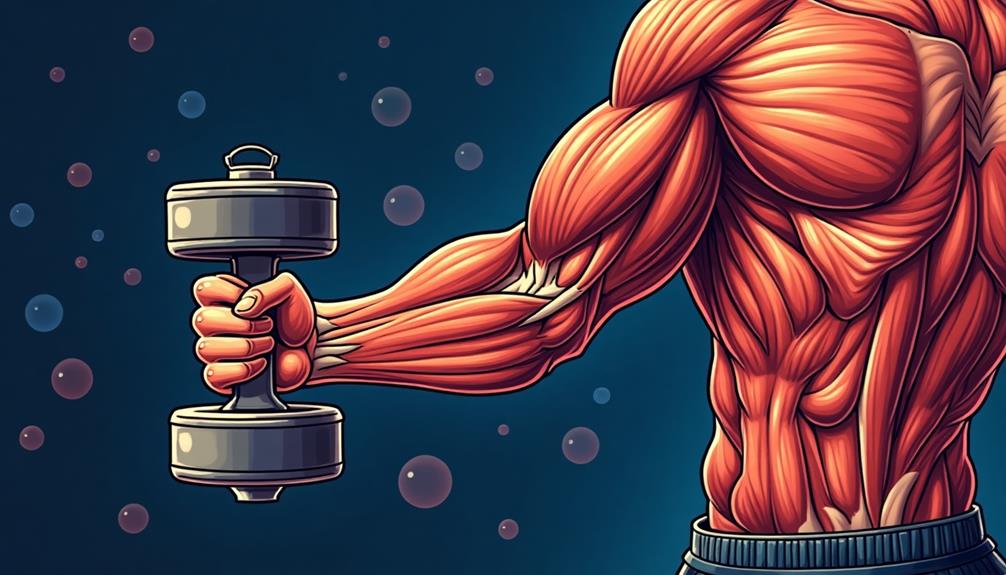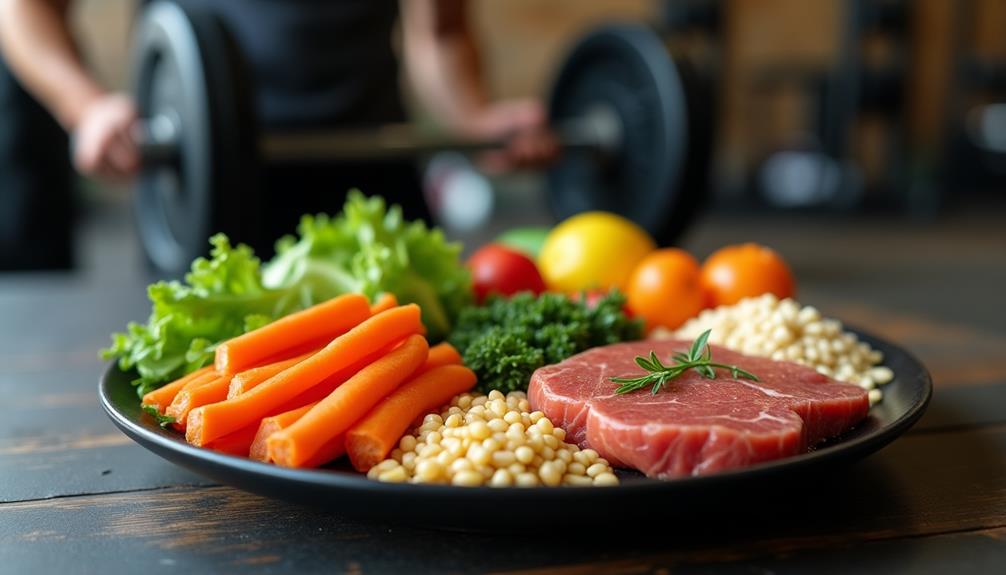Hypertrophy and resistance training are closely linked. Resistance training induces micro-tears in your muscle fibers, which is crucial for muscle growth. When these fibers heal, they adapt and grow in size. This process is activated by mechanical tension and is impacted by factors like workout volume and consistency. To maximize these effects, it's important to incorporate progressive overload, where you gradually raise weights or modify your routines. This guarantees that your muscles consistently encounter new challenges. Want to learn more about enhancing your training for improved results? There's plenty more to delve into on this subject!
Core Insights
- Hypertrophy is achieved through resistance training, which causes muscle fibers to tear and repair, leading to increased muscle size.
- Resistance training creates mechanical tension and muscle damage, both of which are essential signals for muscle adaptation and growth.
- Progressive overload in resistance training is crucial for stimulating hypertrophy by gradually increasing weights, repetitions, and varying exercises.
- Different forms of resistance training, such as free weights and bodyweight exercises, enhance muscle activation and promote hypertrophy through diverse stimuli.
- Consistency in resistance training is vital, as regular workouts lead to sustained muscle adaptation and maximized hypertrophy over time.
Understanding Hypertrophy

Understanding hypertrophy is essential for anyone serious about building muscle. Hypertrophy refers to the increase in muscle size, primarily resulting from resistance training. When you challenge your muscles, tiny tears occur in the muscle fibers. Your body repairs these tears, leading to larger and stronger muscles. Some individuals may consider testosterone boosters to support their muscle-building goals, though results can vary notably.
There are two main types of hypertrophy: myofibrillar and sarcoplasmic. Myofibrillar hypertrophy focuses on increasing the density of muscle fibers, while sarcoplasmic hypertrophy enhances the storage of glycogen in the muscles.
To stimulate hypertrophy effectively, you should prioritize progressive overload, which means gradually increasing the resistance or intensity of your workouts. Consistency is key, as regular training allows your body to adapt and grow. Understanding these principles lays the groundwork for your muscle-building journey.
The Role of Resistance Training

Resistance training stands as the cornerstone of any effective muscle-building program. By participating in exercises that challenge your muscles, you stimulate growth and strength. This approach includes various forms of weight lifting, bodyweight exercises, and resistance bands. Integrating testosterone-boosting supplements can further amplify the effects of resistance training, potentially enhancing workout performance and muscle recovery.
When you lift weights, you create micro-tears in your muscle fibers. Your body then repairs these tears, leading to increased muscle size and strength. It is crucial to vary your routine, incorporating different exercises and rep ranges to keep your muscles guessing and adapting.
Moreover, resistance training not only builds muscle but also improves bone density and overall functional fitness. By dedicating yourself to a consistent resistance training program, you are laying the foundation for long-term success in your fitness journey.
Mechanisms of Muscle Growth

Muscle growth occurs through a complex interplay of biological processes that your body initiates in response to resistance training. Understanding these mechanisms can help you optimize your workouts. Here's a quick overview:
- Mechanical Tension: Lifting heavy weights creates tension in your muscle fibers, signaling them to adapt and grow stronger.
- Muscle Damage: Resistance training causes micro-tears in muscle fibers. Your body repairs these tears, leading to growth.
- Metabolic Stress: Intense workouts lead to the accumulation of metabolites, which can stimulate muscle growth through various pathways.
- Hormonal Response: Resistance training triggers the release of hormones like testosterone and growth hormone, which promote muscle development.
Types of Resistance Training

Exploring various types of resistance training can greatly enhance your workout routine and help you achieve your hypertrophy goals. Here are some popular methods worth examining:
1. Free Weights
Using dumbbells and barbells allows for natural movements. You can target multiple muscle groups and improve coordination. Free weights also offer varying pressure levels throughout the range of motion, which can enhance muscle activation and growth.
2. Machines
Weight machines provide stability and focus on specific muscles. They're great for beginners or for isolating certain areas.
3. Bodyweight Exercises
Push-ups, pull-ups, and squats use your own weight. These exercises can be done anywhere and help build functional strength.
4. Resistance Bands
These versatile bands add adjustable resistance. They're portable and perfect for both beginners and advanced lifters.
Importance of Progressive Overload

To maximize your gains from any resistance training method, understanding the importance of progressive overload is key. Progressive overload involves gradually increasing the demands on your muscles to stimulate growth and strength. Here's how you can implement it:
- Increase Weight: Gradually lift heavier weights to challenge your muscles.
- Increase Repetitions: Add more reps to your sets for added intensity.
- Decrease Rest Time: Shortening rest periods keeps your muscles under strain.
- Change Exercises: Switch up your routine to target different muscle groups.
Nutrition's Impact on Hypertrophy

While you might focus on lifting heavier weights and sticking to a consistent routine, nutrition plays an important role in maximizing hypertrophy. Proper nutrition fuels your workouts and aids recovery, making it essential for muscle growth.
Macronutrients Matter
To promote hypertrophy, make sure you're consuming enough protein, carbohydrates, and healthy fats. Protein helps repair and build muscle tissues, while carbohydrates provide the energy needed for intense workouts. Healthy fats support hormone production, which is crucial for muscle growth.
Timing is Key
Don't overlook nutrient timing. Eating protein and carbohydrates shortly after your workout can enhance recovery and muscle protein synthesis. Remember, a balanced diet combined with your training regimen creates the optimal environment for hypertrophy. Prioritize your nutrition to see the best results in your strength training journey.
Training Frequency and Volume

Nutrition sets the stage for your success in hypertrophy, but the way you structure your training also plays an essential role. Focusing on training frequency and volume can help maximize your muscle growth. Here are some key points to ponder:
- Frequency: Aim for training each muscle group at least twice a week for best gains.
- Volume: Incorporate 10 to 20 sets per muscle group weekly, adjusting based on your experience and recovery.
- Intensity: Utilize a mix of heavy and moderate weights to challenge your muscles effectively.
- Recovery: Allow adequate rest between sessions to prevent overtraining and support muscle repair.
Common Misconceptions

When it comes to hypertrophy and resistance training, several common misconceptions can hinder your progress. One major myth is that lifting heavy weights is the only way to build muscle. While heavy resistance is important, lighter weights with higher repetitions can also promote hypertrophy. Another misconception is that you need to spend hours in the gym. Quality over quantity is key; focused, shorter workouts can be just as effective. Many people also believe that you must train each muscle group every day. In reality, muscles need time to recover and grow. Finally, some think that dietary protein alone guarantees muscle gains, but without proper training, those gains won't materialize. Understanding these misconceptions can help you tailor your training for better results.
Practical Tips for Implementation

To effectively implement hypertrophy principles in your resistance training routine, start by establishing a structured plan that includes progressive overload. This approach guarantees continuous muscle growth and adaptation. Here are four practical tips to help you get started:
- Choose the Right Reps: Aim for 6-12 repetitions per set to optimize hypertrophy.
- Increase Weights Gradually: Add weight or resistance when you can comfortably complete all sets and reps.
- Vary Your Exercises: Incorporate compound and isolation movements to target different muscle groups.
- Prioritize Recovery: Allow adequate rest between workouts and make sure you're getting quality sleep.
Frequently Asked Questions
Can Hypertrophy Occur Without Resistance Training?
Yes, hypertrophy can occur without traditional resistance training. Activities like bodyweight exercises or high-repetition movements can stimulate muscle growth. However, resistance training typically provides more effective and targeted results for significant hypertrophy development.
How Does Age Affect Hypertrophy and Resistance Training Results?
As you age, your body's ability to build muscle can feel like it's slowing down to a crawl. However, consistent resistance training can still lead to impressive hypertrophy, regardless of your age. Keep pushing!
What Role Do Genetics Play in Muscle Hypertrophy?
Genetics play a significant role in muscle hypertrophy. They influence your muscle fiber composition, hormonal responses, and recovery abilities, which can affect how effectively you gain muscle mass from your training efforts.
Are There Specific Exercises Best for Hypertrophy?
To maximize hypertrophy, focus on compound exercises like squats, deadlifts, and bench presses. These movements engage multiple muscle groups, promoting growth. Don't forget to incorporate isolation exercises to target specific muscles effectively and prevent imbalances.
How Can Mental Focus Improve Hypertrophy During Resistance Training?
Isn't it amazing how your mind can boost your gains? By focusing on each rep and visualizing your progress, you enhance muscle engagement, leading to better hypertrophy results during resistance training. Stay mentally present!

